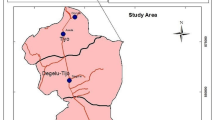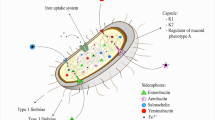Abstract
This study reports the distribution of enterotoxigenic determinants among staphylococci and the susceptibility of staphylococci to various classes of antibiotics. We observed all the isolates as resistant to beta-lactam antibiotics and a few as resistant to non-beta-lactam antibiotics such as clindamycin (47.4%), erythromycin (44.7%), gentamicin (23.7%), norfloxacin (34.2%), tetracycline (26.3%), trimethoprim-sulfamethoxazole (15.8%) etc. The resistance of S. sciuri (n = 1) and S. haemolyticus (n = 1) to rifampicin and intermediate resistance of S. gallinarum (n = 2) to teicoplanin, a high-end antibiotic, are also observed in this study. The multidrug-resistance (≥ 3 classes of antibiotics) was recorded in 23 (60.5%) isolates. The virulomes such as sea, seb, seg and sei were identified predominantly in S. haemolyticus. Surprisingly, certain isolates which were phenotypically confirmed as biofilm-producers by Congo red agar (CRA) test did not harbor biofilm-associated loci. This implies the protein-mediated mechanism of biofilm formation as an alternative to polysaccharide intercellular adhesin (PIA) in staphylococci. However, icaAD locus which encodes PIA was identified in 10 (26.3%) isolates and the eno locus, encoding elastin-binding protein which can accelerate the biofilm production, is identified in all the isolates. The possession of type V SCCmec elements by the S. haemolyticus (15.8%) raised the concern about the rapid dissemination of mecA gene to other species of staphylococci including the virulent S. aureus. In short, this study acknowledges the toxigenicity of coagulase-negative staphylococci (CoNS). Through this study, surveillance of antimicrobial resistance and transference of virulomes in staphylococci is warranted.

Similar content being viewed by others
Availability of data and material
Not applicable.
References
Arciola CR, Campoccia D, Ravaioli S, Montanaro L (2015) Polysaccharide intercellular adhesion in biofilm: structural and regulatory aspects. Front Cell Infect Microbiol. https://doi.org/10.3389/fcimb.2015.00007
Barros EM, Ceotto H, Bastos MCF, Dos Santos KRN, Giambiagi-deMarval M (2012) Staphylococcus haemolyticus as an important hospital pathogen and carrier of methicillin resistance genes. J Clin Microbiol 50(1):166–168. https://doi.org/10.1128/JCM.05563-11
Bemer-Melchior P, Drugeon HB (2001) Choice of the NaCl Concentration for optimizing the detection of methicillin resistance in Staphylococcus using the gel diffusion method. Parodontol 49(3):216–221
Bitrus AA, Zunita Z, Bejo SK, Othman S, Nadzir NAA (2017) In vitro transfer of methicillin resistance determinants mecA from methicillin resistant Staphylococcus aureus (MRSA) to methicillin susceptible Staphylococcus aureus (MSSA). BMC Microbiol. https://doi.org/10.1186/s12866-017-0994-6
Boles BR, Thoende M, Roth AJ, Horswill AR (2010) Identification of genes involved in polysaccharide-independent Staphylococcus aureus biofilm formation. PLoS One. https://doi.org/10.1371/journal.pone.0010146
Bose S, Khodke M, Basak S, Mallick SK (2009) Detection of biofilm producing staphylococci: need of the hour. J Clin Diagnos Res 3(6):1915–1920
Bouchami O, Ben Hassen A, De Lencastre H, Miragaia M (2012) High prevalence of mec complex C and ccrC is independent of SCCmec type V in Staphylococcus haemolyticus. Eur J Clin Microbiol Infect Dis 31(4):605–614. https://doi.org/10.1007/s10096-011-1354-3
Chajęcka-Wierzchowska W, Gajewska J, Wiśniewski P, Zadernowska A (2020) Enterotoxigenic potential of coagulase-negative staphylococci from ready-to-eat food. Pathogens 9(9):1–12. https://doi.org/10.3390/pathogens9090734
Chen TR, Chiou CS, Tsen HY (2004) Use of novel PCR primers specific to the genes of staphylococcal enterotoxin G, H, I for the survey of Staphylococcus aureus strains isolated from food-poisoning cases and food samples in Taiwan. Int J Food Microbiol 92(2):189–197. https://doi.org/10.1016/j.ijfoodmicro.2003.10.002
Chen Q, Xie S, Lou X et al (2020) Biofilm formation and prevalence of adhesion genes among Staphylococcus aureus isolates from different food sources. Microbiologyopen. https://doi.org/10.1002/mbo3.946
Chenouf NS, Mama OM, Messaï CR et al (2021) Detection of methicillin-resistant coagulase-negative staphylococci and PVL/mecA genes in cefoxitin-susceptible Staphylococcus aureus (t044/ST80) from unpasteurized milk sold in stores in Djelfa, Algeria. J Dairy Sci 104(3):2684–2692. https://doi.org/10.3168/jds.2020-19270
Clinical and Laboratory Standards Institute (2020) Performance standards for antimicrobial susceptibility testing; CLSI document M100, 30th edn. CLSI, Wayne, PA
Ghaznavi-Rad E, Fard-Mousavi N, Shahsavari A, Japoni-Nejad A, Van Belkum A (2018) Distribution of staphylococcal cassette chromosome mec types among methicillin-resistant coagulase negative staphylococci in central Iran. Iran J Microbiol 10(1):7–13
Hammad AM, Watanabe W, Fujii T, Shimamoto T (2012) Occurrence and characteristics of methicillin-resistant and -susceptible Staphylococcus aureus and methicillin-resistant coagulase-negative staphylococci from Japanese retail ready-to-eat raw fish. Int J Food Microbiol 156(3):286–289. https://doi.org/10.1016/j.ijfoodmicro.2012.03.022
Helak I, Daczkowska-Kozon EG, Dłubała AA (2020) Short communication: enterotoxigenic potential of coagulase-negative staphylococci isolated from bovine milk in Poland. J Dairy Sci 103(4):3076–3081. https://doi.org/10.3168/jds.2019-17574
Hong JS, Kim D, Kang DY et al (2019) Evaluation of the BD Phoenix M50 automated microbiology system for antimicrobial susceptibility testing with clinical isolates in Korea. Microb Drug Resist 25(8):1142–1148. https://doi.org/10.1089/mdr.2018.0370
Ito T, Ma XX, Takeuchi F, Okuma K, Yuzawa H, Hiramatsu K (2004) Novel type V staphylococcal cassette chromosome mec driven by a novel cassette chromosome recombinase, ccrC. Antimicrob Agents Chemother 48(7):2637–2651. https://doi.org/10.1128/AAC.48.7.2637-2651.2004
Jarraud S, Cozon G, Vandenesch F, Bes M, Etienne J, Lina G (1999) Involvement of enterotoxins G and I in staphylococcal toxic shock syndrome and staphylococcal scarlet fever. J Clin Microbiol 37(8):2446–2449. https://doi.org/10.1128/jcm.37.8.2446-2449.1999
Kiem S, Oh WS, Peck KR et al (2004) Phase variation of biofilm formation in Staphylococcus aureus by IS256 insertion and its impact on the capacity adhering to polyurethane surface. J Korean Med Sci 19(6):779–782. https://doi.org/10.3346/jkms.2004.19.6.779
King DT, Sobhanifar S, Strynadka NCJ (2017) The mechanisms of resistance to β-lactam antibiotics. Handb Antimicrob Resist. https://doi.org/10.1007/978-1-4939-0694-9_10 (Published online)
Kumar LRG, Kasim AK, Lekshmi M, Nayak BB, Kumar S (2016) Incidence of methicillin-resistant staphylococci in fresh seafood. Adv Microbiol 06(06):399–406. https://doi.org/10.4236/aim.2016.66039
Lee JH (2003) Methicillin (Oxacillin)-resistant Staphylococcus aureus strains isolated from major food animals and their potential transmission to humans. Appl Environ Microbiol 69(11):6489–6494. https://doi.org/10.1128/AEM.69.11.6489-6494.2003
Li Y, Lin J, Li L et al (2021) Methicillin-resistant coagulase-negative staphylococci carriage is a protective factor of methicillin-resistant Staphylococcus Aureus nasal colonization in HIV-infected patients: a cross-sectional study. Can J Infect Dis Med Microbiol. https://doi.org/10.1155/2021/5717413
Liberto MC, Matera G, Quirino A et al (2009) Phenotypic and genotypic evaluation of slime production by conventional and molecular microbiological techniques. Microbiol Res 164(5):522–528. https://doi.org/10.1016/j.micres.2007.04.004
Lindsay JA, Ruzin A, Ross HF, Kurepina N, Novick RP (1998) The gene for toxic shock toxin is carried by a family of mobile pathogenicity islands in Staphylococcus aureus. Mol Microbiol 29(2):527–543. https://doi.org/10.1046/j.1365-2958.1998.00947.x
Milheiriço C, Oliveira DC, de Lencastre H (2007) Multiplex PCR strategy for subtyping the staphylococcal cassette chromosome mec type IV in methicillin-resistant Staphylococcus aureus: “SCCmec IV multiplex.” J Antimicrob Chemother 60(1):42–48. https://doi.org/10.1093/jac/dkm112
Notcovich S, DeNicolo G, Flint SH et al (2018) Biofilm-forming potential of Staphylococcus aureus isolated from bovine mastitis in New Zealand. Vet Sci. https://doi.org/10.3390/vetsci5010008
Ochiai T (1999) Salt-sensitive growth of Staphylococcus aureus: stimulation of salt-induced autolysis by multiple environmental factors. Microbiol Immunol 43(7):705–709
Osman K, Alvarez-Ordóñez A, Ruiz L et al (2017) Antimicrobial resistance and virulence characterization of Staphylococcus aureus and coagulase-negative staphylococci from imported beef meat. Ann Clin Microbiol Antimicrob. https://doi.org/10.1186/s12941-017-0210-4
Pedroso SHSP, Sandes SHC, Luiz KCM et al (2016) Biofilm and toxin profile: a phenotypic and genotypic characterization of coagulase-negative staphylococci isolated from human bloodstream infections. Microb Pathog 100:312–318. https://doi.org/10.1016/j.micpath.2016.10.005
Peters G, Schumacher-Perdreau F, Pulverer G (1986) Infections caused by coagulase-negative Staphylococci in immunocompromised patients. Immun Infekt 14(5):165–169. http://www.ncbi.nlm.nih.gov/pubmed/3770797
Pinchuk IV, Beswick EJ, Reyes VE (2010) Staphylococcal enterotoxins. Toxins (basel) 2(8):2177–2197. https://doi.org/10.3390/toxins2082177
Podkowik M, Park JY, Seo KS, Bystroń J, Bania J (2013) Enterotoxigenic potential of coagulase-negative staphylococci. Int J Food Microbiol 163(1):34–40. https://doi.org/10.1016/j.ijfoodmicro.2013.02.005
Ray MD, Boundy S, Archer GL (2016) Transfer of the methicillin resistance genomic island among staphylococci by conjugation. Mol Microbiol 100(4):675–685. https://doi.org/10.1111/mmi.13340
Seng R, Kitti T, Thummeepak R et al (2017) Biofilm formation of methicillin-resistant coagulase negative staphylococci (MR-CoNS) isolated from community and hospital environments. PLoS One. https://doi.org/10.1371/journal.pone.0184172
Sivaraman GK, Muneeb KH, Sudha S, Shome B, Cole J, Holmes M (2021) Prevalence of virulent and biofilm forming ST88-IV-t2526 methicillin-resistant Staphylococcus aureus clones circulating in local retail fish markets in Assam, India. Food Control. https://doi.org/10.1016/j.foodcont.2021.108098
Tang J, Chen J, Li H, Zeng P, Li J (2013) Characterization of adhesin genes, staphylococcal nuclease, hemolysis, and biofilm formation among Staphylococcus aureus strains isolated from different sources. Foodborne Pathog Dis 10(9):757–763. https://doi.org/10.1089/fpd.2012.1474
Udo EE, Al-Bustan MA, Jacob LE, Chugh TD (1999) Enterotoxin production by coagulase-negative staphylococci in restaurant workers from Kuwait City may be a potential cause of food poisoning. J Med Microbiol 48(9):819–823. https://doi.org/10.1099/00222615-48-9-819
Vestby LK, Grønseth T, Simm R, Nesse LL (2020) Bacterial biofilm and its role in the pathogenesis of disease. Antibiotics. https://doi.org/10.3390/antibiotics9020059
Wekell MM, Manger R, Colburn K, Adams A, Hill W (1994) Microbiological quality of seafoods: viruses, bacteria and parasites. Seafoods Chem Process Technol Qual. https://doi.org/10.1007/978-1-4615-2181-5_11 (Published online)
Acknowledgements
We thank Dr. Rajendran Thomas, Senior Scientist, ICAR-National Research Centre on Pig (NRCP), Assam, India, for providing the lab facility to process the fish samples. We also thank Department of Biotechnology (DBT), Government of India for providing financial support.
Funding
This study was supported by Department of Biotechnology (DBT), Government of India (BT/IN/indo-UK/AMR/06/BRS/2018-19).
Author information
Authors and Affiliations
Contributions
Conceptualisation and design of the study: GKS, BS and MH. Funding acquisition: BS and MH, GKS. Data acquisition and result interpretation: MKH, SS and S. Data curation on ethnography: JC. Original draft preparation: MKH, GKS. Review and editing of manuscript: JC and MH, GKS. All the authors critically reviewed and approved the manuscript for the publication.
Corresponding author
Ethics declarations
Conflict of interest
Authors declare no conflict of interests.
Ethics and approval
Not applicable.
Consent for publication
Not applicable.
Additional information
Communicated by Erko Stackebrandt.
Publisher's Note
Springer Nature remains neutral with regard to jurisdictional claims in published maps and institutional affiliations.
Supplementary Information
Below is the link to the electronic supplementary material.
Rights and permissions
About this article
Cite this article
Muneeb, K.H., Sudha, S., Sivaraman, G.K. et al. Virulence and intermediate resistance to high-end antibiotic (teicoplanin) among coagulase-negative staphylococci sourced from retail market fish. Arch Microbiol 203, 5695–5702 (2021). https://doi.org/10.1007/s00203-021-02558-2
Received:
Revised:
Accepted:
Published:
Issue Date:
DOI: https://doi.org/10.1007/s00203-021-02558-2




